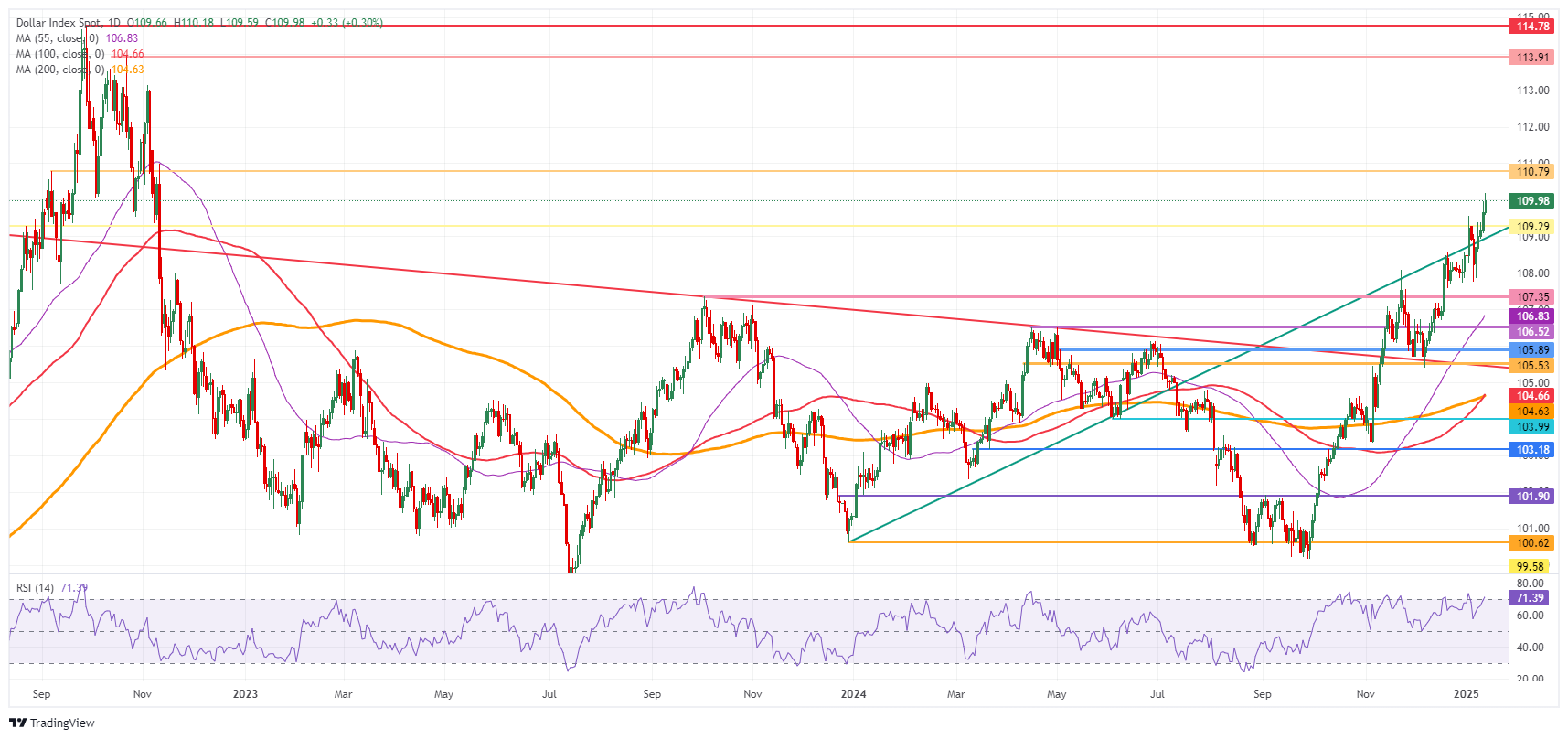US Dollar higher with concerns on Fed’s policy fueling more upside
- The US Dollar trades in the green against nearly every major G20 peer.
- Markets reposition for a more restrictive Fed policy in 2025 after the most recent US employment report.
- The US Dollar Index (DXY) surges to 110.00, looking for consolidation at these upper levels.
The US Dollar Index (DXY), which tracks the Greenback’s value against six major currencies, edges higher for the fifth straight day and trades around 110.00, at levels not seen since November 2022, on Monday. The move comes after markets catch up with the recent Nonfarm Payrolls report for December, released on Friday, and adjusted to the new narrative that the Federal Reserve (Fed) would be more restrictive and keep rates steady for longer, with chances for several interest rate cuts in 2025 diminishing.
The US economic calendar is rather calm in the run-up to the Consumer Price Index (CPI) release on Wednesday and Retail Sales on Thursday. At least this Monday will be a very quiet start, with just a few smaller bond auctions on the agenda. Meanwhile, traders can assess their next moves ahead of President-elect Donald Trump's inauguration next week.
Daily digest market movers: Counting down
- At 16:30 GMT, the US Treasury will allocate a 3-month and a 6-month bill.
- At 19:00 GMT, the December Budget Statement will be released. The deficit is expected to shrink to $62 billion from $367 billion.
- Equities are taking over the negative tone from Asia. Besides Japan being closed, all other major indices are trading in red numbers.
- The CME FedWatch Tool projects a 97.3% chance that interest rates will be kept unchanged at current levels in the January meeting. Expectations are for the Federal Reserve (Fed) to remain data-dependent with uncertainties that could influence the inflation path once President-elect Donald Trump takes office on January 20.
- US yields are softening slightly. The 10-year benchmark is at 4.780%, off the fresh nine-month high of 4.798% seen in Asian trading on Monday.
US Dollar Index Technical Analysis: Is it all priced in?
The US Dollar Index (DXY) is in the last seven days before President-elect Donald Trump takes office. With the changing market narrative towards a longer and more restrictive Fed monetary policy going forward, chances that the Fed might not even cut at all in 2025 could be very plausible. In that case, the ramifications for the Greenback would be that the US Dollar Index would surge even further.
On the upside, the 110.00 psychological barrier needs to be held, and a consolidation must be seen above it for the rally to move higher. Further up, 110.79 remains the next big upside level to hit. Once beyond there, it is quite a stretch to 113.91, the double top from October 2022.
On the downside, the first downside barrier is 107.35, which has now turned into support. The next level that might halt any selling pressure is 106.52, with the 55-day Simple Moving Average (SMA) at 106.83 reinforcing above this region of support.

US Dollar Index: Daily Chart
US Dollar FAQs
The US Dollar (USD) is the official currency of the United States of America, and the ‘de facto’ currency of a significant number of other countries where it is found in circulation alongside local notes. It is the most heavily traded currency in the world, accounting for over 88% of all global foreign exchange turnover, or an average of $6.6 trillion in transactions per day, according to data from 2022. Following the second world war, the USD took over from the British Pound as the world’s reserve currency. For most of its history, the US Dollar was backed by Gold, until the Bretton Woods Agreement in 1971 when the Gold Standard went away.
The most important single factor impacting on the value of the US Dollar is monetary policy, which is shaped by the Federal Reserve (Fed). The Fed has two mandates: to achieve price stability (control inflation) and foster full employment. Its primary tool to achieve these two goals is by adjusting interest rates. When prices are rising too quickly and inflation is above the Fed’s 2% target, the Fed will raise rates, which helps the USD value. When inflation falls below 2% or the Unemployment Rate is too high, the Fed may lower interest rates, which weighs on the Greenback.
In extreme situations, the Federal Reserve can also print more Dollars and enact quantitative easing (QE). QE is the process by which the Fed substantially increases the flow of credit in a stuck financial system. It is a non-standard policy measure used when credit has dried up because banks will not lend to each other (out of the fear of counterparty default). It is a last resort when simply lowering interest rates is unlikely to achieve the necessary result. It was the Fed’s weapon of choice to combat the credit crunch that occurred during the Great Financial Crisis in 2008. It involves the Fed printing more Dollars and using them to buy US government bonds predominantly from financial institutions. QE usually leads to a weaker US Dollar.
Quantitative tightening (QT) is the reverse process whereby the Federal Reserve stops buying bonds from financial institutions and does not reinvest the principal from the bonds it holds maturing in new purchases. It is usually positive for the US Dollar.

